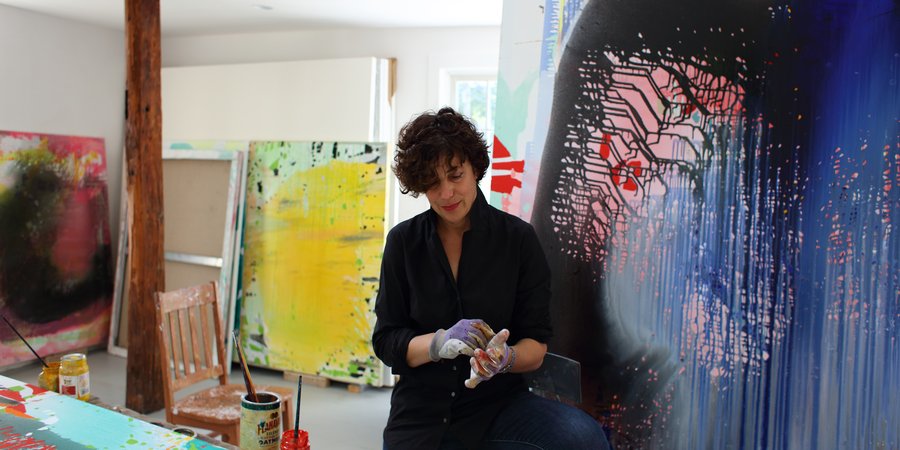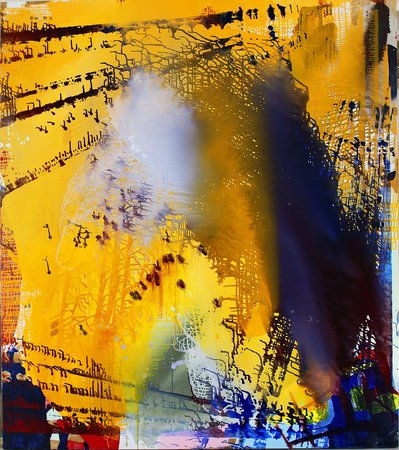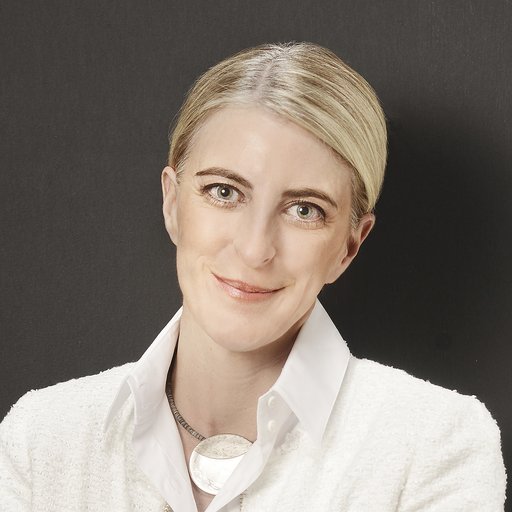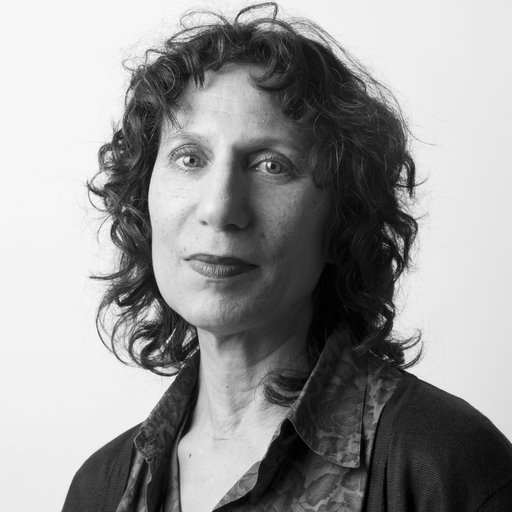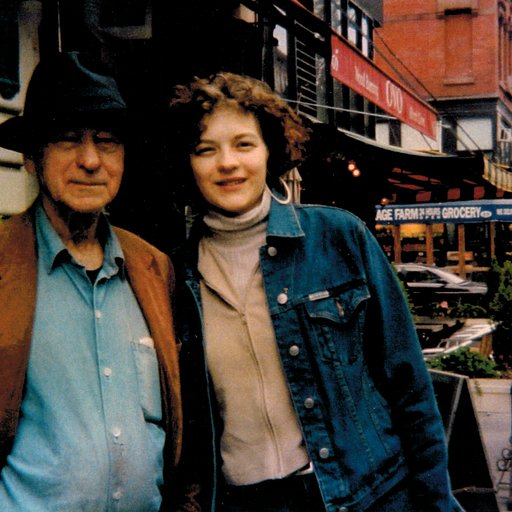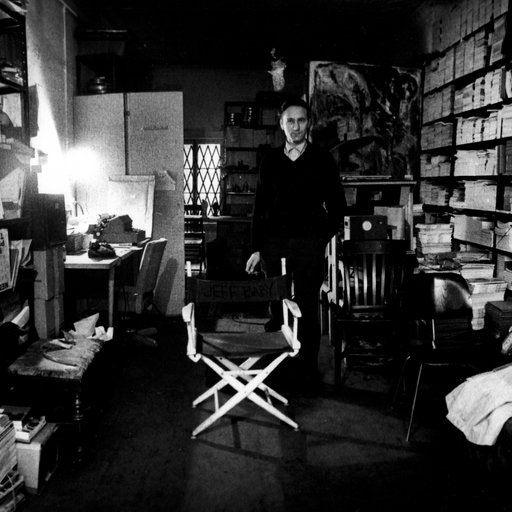For Jackie Saccoccio , the winner of this year’s Artadia NADA Award , painting is not a quiet moment of reflection in front of an easel. Her works unfold through a combination of improvisational pours and gestures across multiple canvases; typically, she lifts one canvas to leave its drippings on another, sharing paint between her compositions.
Her titles tell us that these are “portraits” or “profiles,” although there seems to be no hint of a human figure. But look closer, and the drips and dabs coalesce into a swirling, central presence that draws you in, giving you just an inkling of a real-world referent.
Saccocio, a longtime New York resident, now lives and works in West Cornwall, Connecticut—a small, heavily forested community in the foothills of the Berkshires—with her husband, the sculptor Carl D’Alvia. They share a studio housed in a former general store/local tavern, now modified with higher ceilings to allow Saccoccio the room to maneuver her massive canvases. Artspace’s Dylan Kerr paid a visit as the artist was putting the finishing touches on works for her upcoming double show at Eleven Rivington and Van Doren Waxter, to discuss the architectural, mythological, and rebellious origins of her unique process.
You refer to your works from the past several years as “portraits” or “profiles.” How did you develop this unusual approach to abstraction?
I went to art school in the ‘80s. I thought I was going to be an architect, but I realized that it wasn’t buildings that I wanted to make but rather some kind of connection with space—delving into this vertiginous space, and trying to make something out of that. It was always an illusionistic space, though, not a real space.
My work has been abstract since the early ‘90s, but it wasn’t until a certain point around 2008 that I started playing with this idea of portraiture—the idea that the object, the presence, the mass I was seeing in a lot of portrait painting was this centrifugal force as well as a presence that was coming out. I really wanted that in my paintings. It was about bringing that duality into the painting, from a landscape base.
At the time I was doing these abstracted grids, which were getting larger and larger. As they got bigger, I got more committed to the brushstrokes. The brushstrokes themselves became a kind of object, so I became interested in the paint itself. I started to research painting techniques, and to wonder why we still use oil paints.
The more I researched oils, the more things I found to do with them. I started to use more traditional materials, but in a contemporary way. For example, I started to use mica, which is something Renaissance artists used to mix into their gesso to bring translucency to the surface, but I used it with different varnishes. Then I started to use varnishes not to enhance the paintings but to cut up the surfaces, so some of the surfaces are matte and some are shiny—they don’t really correspond to any object or colors. That led to this idea of reinterpreting portraiture, which seemed like a similar conceit.
Profile (Tender)
, 2015. Courtesy of the artist.
These “reinterpretations” are conspicuously devoid of the human form. How do your paintings function as portraiture?
I did a show in Italy called “Portrait Gallery” where I worked through this idea of how one can make a grid read as a portrait. I usually install these as high up as I can—I like even the large ones to be at least 18 inches high. They have more of a hovering nature to them. I think these are all different ways to manipulate the viewer into having a sensational, physical reaction. I don’t really see portraits as individual things, because the portraits that I’ve always been very attracted to are like the busts in the Capitoline Museum in Rome, or those in portrait galleries like the ones in the Prado, which is where I first got interested in this notion of portrait galleries.
I take a lot of notes when I’m looking at paintings, so I try to dictate a certain limit to what I’m doing in a particular painting based on a series of notes. It may be certain palettes like Mondrian or Yuskavage paintings, or something else like a film. In the case of “Portrait Gallery,” I was thinking about Mannerist paintings.
What kinds of things are you portraying in the paintings for your upcoming shows at Eleven Rivington and Van Doren Waxter?
Two of the paintings are based on Wong Kar-wei’s film Chungking Express , which is about these parallel love stories—two cops get dumped and intersect in this section of Hong Kong called Chungking Mansion, which is famous for the unsavory stuff that goes down there. There’s a little food shop that both cops go to, but they only cross paths slightly in these two vignettes. These paintings are portraits of the characters in that film.
Others are based on the palettes of specific paintings. For instance, this one is called Profile (PM Sweep) . It’s after a Mondrian painting. This one is called Profile (Y ellow Yuskavage) . It’s based on a Lisa Yuskavage painting I saw at a collector’s house about 15 years ago. I was so annoyed by it, I couldn’t get it out of my head.
The primary inspiration for these two upcoming shows is an idea that Cy Twombly addressed really beautifully in one of his last shows in 2006, at Gagosian uptown. He showed the post-painting action within the paintings, and I really wanted this show to focus on the process of painting—to show the whole thing from start to finish. I use the paintings as tools for one another—I let the paint drip from one side to another and let that pool up on another canvas. I wanted this action to be part of the show.

Profile (Yellow Yuskavage) , 2015. Courtesy of the artist and Eleven Rivington.
How much do these inspirations or points of reference guide your painting process, once the work is underway? You’re clearly not holding too tightly to specific images.
Definitely. There’s a lot of improvisation once I get going. I’m carrying one painting around to make the other paintings, so there’s a certain lack of control.
In 2010, I curated a show at the RISD Museum called “Collision,” where I invited people in to work over one another’s work. It felt like a big artist’s project, where I ceded control but nevertheless had a lot of ancillary control because I invited the artists and organized the schedules. From there, though, I didn’t know what they would do. I think that lack of control helps to open up this whole way of working, where it’s much more about pooling and letting the alchemical aspects of the paint happen. It’s about directing but not really enforcing what happens.
Usually, I think a painting is done when I feel a reconnection to the ideas I originally had. They never look like what I expected them to look like, but they have something about them. The Yuskavage painting my work is based on is a stunning lemony yellow—that’s not the palette I used, but I feel like there’s something that that painting conveyed to me that I feel like is in this one. It just feels like what it’s supposed to be.
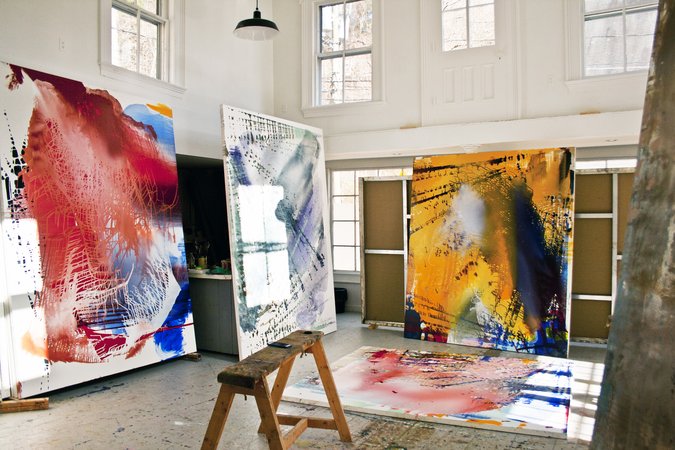 Studio view with works in progress, summer 2015. Courtesy of the artist and Eleven Rivington.
Studio view with works in progress, summer 2015. Courtesy of the artist and Eleven Rivington.
Given the level of chance inherent to your process, it's interesting to hear you say that your paintings don’t turn out exactly as you expect. What kinds of expectations do you have going into a painting?
The paintings are made through an additive process—I don’t do a lot of wiping off. I cover up instead, so there are many layers to the final painting. Oftentimes I’ll start from my notes on a different painting—maybe it has three kinds of grey in certain proportions, for instance, but the end result may not have grey in it all. I guess it’s pretty arbitrary, what my idea is versus the final product. But I’m there mixing paint for a painting, so I’m making decisions about what it’s going to be.
Making these paintings is an intensely physical process—you’re lifting these massive canvasses and slamming them down on one another to make the marks we see. How do you see your paintings in relation to your own body?
They’re enormous paintings, and there’s something that happens on this scale for me—a certain clarity, this mind-body thing that happens when faced with something at this scale. I try to do small paintings, and it’s very difficult for me to deal with just the hand-wrist-mind thing. I don’t have the same understanding, and I’m certainly not able to convey that feeling of mass that I’m trying to.
How did you come up with the idea of using canvases as tools for painting more canvases?
Actually, it has to do with the Ovid myth of Narcissus and Echo . In the story, Echo can only ever express what’s expressed to her. In a similar way, my process is to let the palette of one painting drip onto another canvas, to become a kind of reflection of that painting. At the same time, the paintings don't need one another to make sense even though I use the same tools and residue for multiple paintings. They’re certainly not diptychs.
Studio view with works in progress. Courtesy of the artist.
At first glance, the obvious point of reference for your work is Abstract Expressionism. Do you see yourself as continuing this tradition of American abstraction?
I’m definitely connected to it, but I feel like Pollock was definitely connected to the Hudson River School. I’m certainly part of an American tradition of painting, but it’s not the only thing that’s happening. I love de Kooning , but I love Titian too.
The drip itself is one of the most salient aspects of these recent works, coming out in everything from simple lines to wavy grids. How do you think about the paint drip as a motif in your paintings?
It seems like a really reactionary, smarmy thing to do. Drips in abstract painting? It’s the thing you shouldn’t do. I don’t like when people lump me in with Abstract Expressionism to the exclusion of other influences—it’s certainly a huge influence, but it seems like drips really became a thing with them. It’s become a trigger point: “Oh, there’s a drip there, it must be Abstract Expressionism.” My drips are almost a mockery of that.
I guess this rebellious impulse comes from the idea of my initial approach to making artwork, my love of architecture and early foray into studying it. There’s this idea that paintings are things that get in the way of the architecture. There’s almost a hostility to paintings. It’s a challenge to make a painting that’s on par with the architecture it’s in, so that has a lot to do with the scale I work at as well. It’s a pushback against the architecture.











